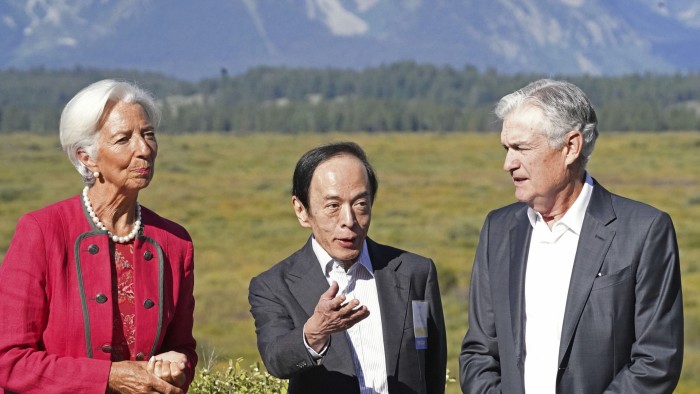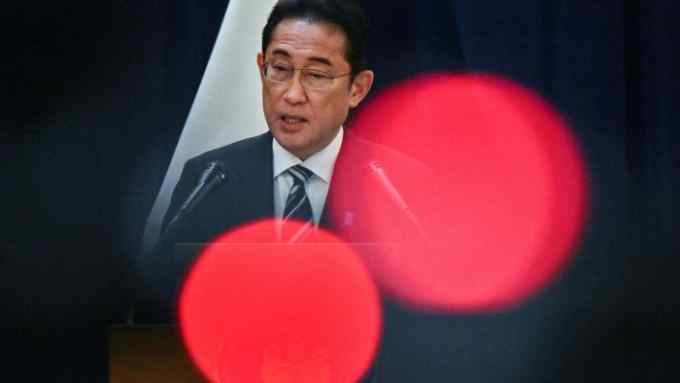Investors read the runes on course of Japan’s monetary policy

Roula Khalaf, Editor of the FT, selects her favourite stories in this weekly newsletter.
Six months after Kazuo Ueda became the first academic to take the helm of the Bank of Japan, investors are still poring over his every word for any hint on when he might start unwinding the country’s ultra-loose monetary policy.
Economists and BoJ watchers remain deeply divided on when the exit could begin, and how it would be carried out.
A disorderly exit would cause a jump in 10-year Japanese government bond yields, a decline in Japan’s main stock index, Topix, and a stifling of the economy — just when the country seems to have lifted itself out of deflation, for the first time in decades.
The ripples of the BoJ’s policy change would also be felt across global financial markets.
Most leading central banks are coming towards the end of the historically rapid tightening cycles that they unleashed in an effort to combat inflation. However, the BoJ has largely held firm, calling for patience until Japan’s relatively mild price increases and rising wages become entrenched.
In the past few weeks alone, investor predictions on the Japanese central bank’s next move have swung from hawkish to dovish.
The 72-year-old governor, meanwhile, has played down earlier interview comments that appeared to signal the lifting of negative interest rates by the year’s end. They had been followed by the yen dropping to ¥149.5 per dollar, its lowest level in 11 months, and the 10-year Japanese government bond yield hitting 0.745 per cent, its highest level since September 2013.
People close to Ueda say the governor, while choosing his words carefully, tends to speak his mind freely as opposed to his predecessor Haruhiko Kuroda. The latter, a former top currency bureaucrat, was mostly given to reading off the script provided by central bank officials.
And, without that consistency in language, the challenge for global investors trying to interpret the BoJ chief’s words is now even bigger.
Ueda, himself, faces an extremely delicate task of communicating his strategy to investors, whose radars are beeping for any sign of change.
With rising prices and wages, as well as the widening interest rate differential between Japan and the US, any concern that the central bank was falling behind the curve in the global battle against inflation would send the yen tumbling lower. On the other hand, if investors see Ueda in a rush to normalise policy, that would also cause turmoil in the financial markets.
So far, analysts say Ueda has been successful with his balancing act.
In July, the central bank cleverly tweaked its cap on 10-year bond yields without causing financial markets to fear an imminent rise in interest rates.
It did that by raising the hard cap on 10-year bond yields to 1 per cent, while still keeping the 0.5 per cent cap as a “reference”.
At the present time, the prime focus is on when the central bank will lift its base rate, which remains at minus 0.1 per cent.
In an interview with newspaper Yomiuri Shimbun, in early September, Ueda said it was “not impossible that we will have enough information and data by the end of this year” on the outlook for wage increases next spring.
He also said that the central bank “does not actively embrace a ‘behind the curve’ situation”.
His comments prompted immediate market speculation that the next major policy move would come in December.
But, at a news conference in Osaka late last month, Ueda stressed that it was not possible to specify the timing on when it would make a judgment for policy revision. He also noted that the risk of the BoJ not sustainably achieving its 2 per cent inflation target was bigger than the risk of falling behind the curve.
Considering the way the BoJ loosened its controls on the bond market in July, Hiroshi Miyazaki, senior economist at Mizuho Research & Technologies Institute, says the central bank could decide to lift negative interest rates in phases rather than at one go.
There is probably a need to emphasise “that the BoJ would embark on policy revision with extra caution”, Miyazaki says, citing the government’s nervousness about the depreciation in the yen.
Meanwhile, Morgan Stanley MUFG Securities expects the BoJ to remove negative interest rates and its yield curve controls in January, but notes the risk of an early move in December.
In bringing forward the expected timing of the BoJ’s policy change, its chief economist Takeshi Yamaguchi cites what he thinks is a shift in Ueda’s language to a hawkish tone on the back of stickier inflation and advances in yen depreciation.
In a further sign of the wide division in market views, UBS economist Masamichi Adachi says he no longer expects the BoJ to make a major policy revision until mid-2025. The Swiss bank predicts that the US economy would fall into a recession later this year and that the US Federal Reserve continue cutting rates until the spring of 2025.
If the US economy continues to be resilient, Adachi says the BoJ could lift 10-year yields from zero per cent to as far as 0.5 per cent and further relax its yield curve controls later this month — a move that would provide insurance against rising inflation and further yen weakness at limited cost.
He then expects the central bank to remove negative interest rates as early as in April.
“For the BoJ to normalise its policy, the US and global economy needs to stay resilient and Japan’s wage growth needs to be robust,” Adachi says, adding that the biggest risk factor for the BoJ’s policy decision was not whether inflation continued to be high but the uncertainty over the world’s largest economy.

Comments